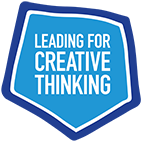Leading for Creativity: To inspire teaching and learning for creativity across the curriculum
Sarah Childs, Penryn Creativity Collaborative (PCC) Lead and Lead Practitioner, reflects on the leadership journey Penryn College has been on over the last three years.
The big picture
From the outset, our ambition at Penryn College was to inspire Teaching and Learning for a future curriculum, ensuring that teaching for creativity was cultivated across the school.
We knew this meant:
- Leaders and teachers would need to promote and implement change for the teaching of creativity
- Increasing staff capability in teaching for creativity.
To support this, we knew this needed us to:
- Develop a model for developing pedagogy across the school
- Create a framework for how to prepare young people for a changing workforce
- Develop a model for developing creative skills across the school curriculum.
What we learnt in Year 1 to prepare for leading change
During Year 1 we set out to ‘Question, Challenge and Explore,’ taking time to review existing literature and practice. We learnt quickly that it was hard to define creativity in schools. We found from teachers and students that creativity was often associated with the arts and they felt that both strong subject knowledge and skills are required for creative thinking to occur. Leaders also suggested that we needed examples of teaching for creativity across the curriculum to support change moving forward.
To implement change for the teaching of creativity we needed to establish a shared language. Created with the University of Exeter (UoE), our Penryn Creativity Collaboratives (PCC) Model of Creative Skills drew on understandings from the Durham Commission, NACCE Report, key creativity theories (Possibility Thinking, Wise Humanising Creativity, Posthumanising Creativity, Five-Dimensional Model of Creativity, the Australian Curriculum model, the UK Qualifications and Curriculum Authority Framework). We developed our language with leaders, teachers, students, and local industry and cultural partners to ensure we represented our local context.


Our simple approach
At Penryn College we decided to work within existing structures and systems for teaching and learning (T&L) across the school. We explored teaching for creativity as an opportunity to energise and invigorate existing classroom practice, using our already embedded steps to school improvement. Each year we aimed to expand the place for teaching for creativity within our school culture from leadership and management, quality of education and personal development. This was embraced through our existing leadership structure for cultivating T&L which includes; Senior Leadership team (SLT), teaching and learning team, Heads of Faculty (middle leaders) and our Coach Education Programme.
During Year 2 UoE led us through an Action Research Model (ARM) to develop creative pedagogies and skills whilst evidencing the impact with a core team of classroom teachers. We then weaved the development of teaching for creativity through our whole school priorities using our existing shared language for pedagogy across the school along with our creative skills. We lent on our existing CPD opportunities including one-to-one coaching, twilight CPD sessions, INSET days, professional review, morning briefing sessions and T&L bulletins. Leaders, including Governors, had a strategic role, fostering opportunities for challenge and thought-provoking conversation. And finally, we thrived working within partnership to build a wider learning community. Working alongside local industry and cultural partners brought a wealth of knowledge, expertise and depth about how we better prepare young people for a modern workforce.
Our SWOT analysis
Reflecting on our approach to developing teaching for creativity it may be helpful for other school leaders to consider our self-evaluation.

Lessons learned (so far)
From our journey here are some tips for developing teaching for creativity across the curriculum which others may find helpful:
Build a shared language for teaching and learning, keep it simple and within your usual approach for your school when discussing pedagogy. Share experiences and approaches from schools both nationally and internationally, so that leaders and teachers can visualise opportunities and potential impact when implementing any change.
Consider the potential for a colleague to lead on developing teaching for creativity, whether an SLT role, lead practitioner role or middle leader working within whole school teaching and learning.
Develop a coaching model to support colleagues to work across the school developing pedagogy through professional dialogue. Build a team of experienced coaches who lean on research informed approaches, using action research, to work with teachers on developing their pedagogy. If you want to learn more, please see our ‘Developing Action Research’ resource in the PCC Toolkit - Penryn College (penryn-college.cornwall.sch.uk)
Crickmay, U. Childs, S. Chappell, K (2023)
Preparing for a Creative Future: Year One Report Question, Challenge and Explore.
Preparing for a Creative Future: Year Two Report Build and Test
https://penryn-college.cornwall.sch.uk/creativity-collaboratives/
Reflecting together
- What would your shared language be for teaching for creativity?
- What opportunities do you have within your existing structures for developing teaching and learning?
- What opportunities can developing teaching for creativity bring to your teaching and learning priorities? What opportunities do you have in your CPD calendar to share approaches to teaching for creativity?
- Where and how might it be helpful for you to draw on partners’ expertise to shape this work?
